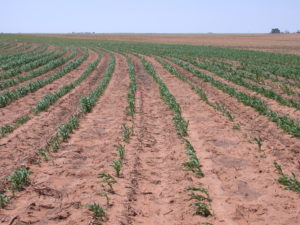by Calvin Trostle, Extension Agronomy, Lubbock, (806) 723-8432, ctrostle@ag.tamu.edu
In recent newsletters for Texas Grain Sorghum Association I first discussed row spacing for grain sorghum then especially in-row spacing of seed drop and the accuracy (or lack thereof) of uniform seed spacing within the row (see http://texassorghum.org/sorghum-tips). Here, I expand the with-in row discussion to all Texas row crops.
On a smaller scale of about two to six inches within any row spacing, it may seem the uniformity of seed spacing is not that important for row crops. Yes, it is true that the root system, for example, will basically still explore the same area and leaf area will be about the same. But varieties (or hybrids) of corn, grain sorghum, cotton, soybean, guar, or cowpeas do respond differently to spacing around the individual plant with more tillering or branching than others. This can be a positive effect (a plant accounts for extra space and yield potential by tillering or additional branching to compensate for a gap in the row) or negative effect (excess tillering is not desirable in moisture-limited production).
Having uniform plant spacing within the row is a plus—as is your planter actually placing the correct number of seed that you desire. We are most immediately concerned about larger gaps of 12” or more—they are obvious, especially if you are planting 3 to 6 seeds per foot of row. Sometimes trash or other factors in the field (as well as worn out equipment like a trash whipper or disc opener) may interfere with seed placement and emergence (Fig. 1), but the same principle applies like I discussed in sorghum row spacing, uniformly distributed plants is favorable.
The faster you plant on rough ground you will also lose incrementally some of your uniform spacing in the seed drop. I am not the first one to advise producers to “slow down” when you are planting.
Confirming the Desired Seed Drop of Individual Planter Units
In recent testing on a late model John Deere 8-row air-vacuum planter at one of our AgriLife Research facilities, I found two rows dropped 17% or more seed than they should have, and one row was 20% less than what was targeted. Pending the production conditions this creates a potentially non-agronomic plant population within the row.
I recommend a two-fold approach:
- Once you have your crop seed on hand set the planter up with your plates and settings and seed, turn the drive wheel a set distance and catch seed to calculate the number of seeds per foot for up to four planter units. How does this match with your planter book and how much seed it says you should be dropping? This step confirms if your planter is dropping the amount of seed you wanted. If it is not then you can investigate further and adjust your planter settings.
- It may be too much effort to check each individual planter unit for accuracy of seed drop, especially for planters more than eight rows. First, do you notice the volume of seed in one planter box of seed is changing more quickly or slowly than the rest? Check that unit in the field right away. More likely, after planting watch your young plant stands to see if you have a row that readily appears to be thick or thin (Fig. 2; if thin, be sure there is not some factor like in Fig. 1). If you find a row that readily appears to have a higher or lower number of plants, then verify this in companion rows in other planter passes across the field. If this is consistent then you have a planter unit that is off. You are likely underpopulated or overpopulated in that row. It needs to be corrected. Of the hundreds of fields I have walked in over the years, a row that is dropping double or triple the number of seed is the most common issue and readily noticed—don’t ignore it! Figure out which planter unit that is. There is likely a brush not set properly, or even missing, or some other easily fixed issue.
“I already planted all my row crop. I will consider this next year…”
Actually, when your crop is young, it is a good time to evaluate the stands you have in individual rows. Refer back to #2 above. Do you have skips? Do you have a row that looks thicker–or thinner—than normal? Usually you can tell from the tractor tire track ribs which direction the planter was moving so you know which row unit of the planter may have a thickly or thinly seeded row. So, make the check on the culprit planter unit and ensure future rows from that unit will have the desired agronomics you want for your row crop.


